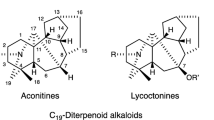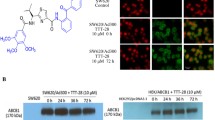Abstract
P-Glycoprotein (P-gp), an ATP-binding cassette transporter, plays an important role in multidrug resistance (MDR). α-Asarone and β-asarone, bioactive cis–trans isomers found in Acorus tatarinowii Schott, were tested for their potential ability to modulate the expression and function of P-gp in Caco-2 cells. MTT assays revealed that both α-asarone and β-asarone significantly enhanced the vincristine-induced cytotoxicity to cells. β-Asarone was the most potent. Flow cytometry showed that α- and β-asarone increased Rhodamine 123 (Rh123) uptake and inhibited Rh123 efflux in Caco-2 cells in a concentration-dependent manner. Furthermore, P-gp expression and P-gp mRNA in cells were decreased by exposure to α- and β-asarone. In addition, β-asarone increased the inhibition of P-gp activity in cells more than α-asarone. Thus, α- and β-asarone effectively reversed MDR by inhibiting P-gp function and expression.



Similar content being viewed by others
References
Chaudhary PM, Mechetner EB, Roninson IB (1992) Expression and activity of the multidrug resistance P-glycoprotein in human peripheral blood lymphocytes. Blood 80:2735–2739
Chen H, Li WG, Zhang XB, Wang L, Xu TL, Wu DZ, Li Y (2013) Alpha-asarone from Acorus gramineus alleviates epilepsy by modulating A-type gaba receptors. Neuropharmacology 65:1–11
Dandiya PC, Menon MK (1964) Actions of asarone on behavior, stress, and hyperpyrexia, and its interactions with central stimulants. J Pharmacol Exp Ther 145:42–46
Fromm MF, Kim RB, Stein CM, Wilkinson GR, Roden DM (1999) Inhibition of P-glycoprotein-mediated drug transport: a unifying mechanism to explain the interaction between digoxin and quinidine. Circulation 99:552–557
Garduno L, Salazar M, Salazar S, Morelos ME, Labarrios F, Tamariz J, Chamorro GA (1997) Hypolipidaemic activity of α-asarone in mice. J Ethnopharmacol 55:161–163
Green LJ, Marder P, Slapak CA (2001) Modulation by LY335979 of P-glycoprotein function in multidrug-resistant cell lines and human natural killer cells. Biochem Pharmacol 61:1393–1399
Ito S, Woodland C, Harper PA, Koren G (1993) The mechanism of the verapamil–digoxin interaction in renal tubular cells (LLC-PK1). Life Sci 53:399–403
Juliano RL (1976) The role of drug delivery systems in cancer chemotherapy. Prog Clin Biol Res 9:21–32
Lee B, Choi Y, Kim H, Kim SY, Hahm DH, Lee HJ, Shim I (2003) Protective effects of methanol extract of Acori graminei rhizoma and Uncariae ramulus et Uncus on ischemia-induced neuronal death and cognitive impairments in the rat. Life Sci 74:435–450
Liu J, Li C, Xing G, Zhou L, Dong M, Geng Y, Li X, Li J, Wang G, Zou D, Niu Y (2010) Beta-asarone attenuates neuronal apoptosis induced by beta amyloid in rat hippocampus. Yakugaku Zasshi 130:737–746
Lucia MB, Cauda R, Landay AL, Malorni W, Donelli G, Ortona L (1995) Transmembrane P-glycoprotein (P-gp/P-170) in HIV infection: analysis of lymphocyte surface expression and drug-unrelated function. AIDS Res Hum Retrovir 11:893–901
Okamura N, Hirai M, Tanigawara Y, Tanaka K, Yasuhara M, Ueda K, Komano T, Hori R (1993) Digoxin–cyclosporin A interaction: modulation of the multidrug transporter P-glycoprotein in the kidney. J Pharmacol Exp Ther 266:1614–1619
Tan B, Piwnica-Worms D, Ratner L (2000) Multidrug resistance transporters and modulation. Curr Opin Oncol 12:450–458
Wang EJ, Casciano CN, Clement RP, Johnson WW (2001) Active transport of fluorescent P-glycoprotein substrates: evaluation as markers and interaction with inhibitors. Biochem Biophys Res Commun 289:580–585
Wu QD, Fang YQ, Chen YZ, Kuan ZS, Wang SY, He YP (2005) Protective eEffects of volatile oil of Acorus tatarinowii Schott and β-asarone on cardiovascular system. Tradit Chin Drug Res Clin Pharmacol 4:244–247
Yang K, Wu J, Li X (2008) Recent advances in the research of P-glycoprotein inhibitors. Biosci Trends 2:137–146
Yang Y, Wang SX, Fang MF, Yang LJ, Meng X, Zheng XH (2012) Modulation of P-glycoprotein by benzaldehyde, vanillin and β-asarone. Chin Tradit Pat Med 7:1364–1366
Zamora JM, Pearce HL, Beck WT (1988) Physical–chemical properties shared by compounds that modulate multidrug resistance in human leukemia cells. Mol Pharmacol 33:454–462
Zuo HL, Yang FQ, Zhang XM, Xia ZN (2011) Separation of cis-and trans-asarone from Acorus tatarinowii by preparative gas chromatography. J Anal Methods Chem 2012:1–5
Acknowledgments
This work was supported by Education, Science, and Technology Development Center (IRT1174); Ministry of Science and Technology of the People’s Republic of China (No. 2008BAI51B01); Science, Industry, Trade and Information Technology Commission of Shenzhen Municipality, China (JC201005280632A, CXB201005260069A); and National Natural Science Foundation of China (No. 21005060).
Author information
Authors and Affiliations
Corresponding author
Rights and permissions
About this article
Cite this article
Meng, X., Liao, S., Wang, X. et al. Reversing P-glycoprotein-mediated multidrug resistance in vitro by α-asarone and β-asarone, bioactive cis–trans isomers from Acorus tatarinowii . Biotechnol Lett 36, 685–691 (2014). https://doi.org/10.1007/s10529-013-1419-8
Received:
Accepted:
Published:
Issue Date:
DOI: https://doi.org/10.1007/s10529-013-1419-8




